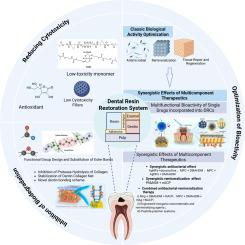Strategies for enhancing biocompatibility, bioactivity, and resistance to biodegradation in dental resin composites: A narrative review
IF 6
2区 医学
Q2 MATERIALS SCIENCE, BIOMATERIALS
Materials Science & Engineering C-Materials for Biological Applications
Pub Date : 2025-09-09
DOI:10.1016/j.bioadv.2025.214496
引用次数: 0
Abstract
Dental resin composites (DRCs), while indispensable in restorative dentistry for addressing tooth defects, are constrained by several inherent limitations. Conventional DRCs not only have cytotoxic potential but also undergo accelerated biodegradation mediated by host-derived enzymes and oral microbiota. Additionally, conventional DRCs are inherently bioinert—lacking the bioactivity required to inhibit the initiation and progression of secondary caries. Existing studies have found that degradation byproducts of DRCs may enhance the virulence of cariogenic pathogens. Concurrently, microleakage at resin-dentin interfaces causes salivary permeation and biofilm colonization, collectively establishing a pathogenic ‘degradation-infection’ feedback cycle. Furthermore, residual monomer release during biodegradation exacerbates cytotoxic responses, thereby generating synergistic “degradation-toxicity” compounding effects. These compounding effects severely compromise the clinical longevity and functional stability of DRC-based restorations. Therefore, this review comprehensively examines the factors and mechanisms underlying the cytotoxicity and biodegradation of conventional DRCs in oral environments from both bacterial and host perspectives. It also discusses their early-stage application profile characterized by “mere structural repair”—reflecting bioinertness. In addition, this review places particular focus on design strategies for novel DRCs intended to overcome these limitations and to impart improved biological performance. This review provides a theoretical framework for the biological optimization of DRCs and offers new ideas for developing next-generation DRCs with both biological safety and clinical durability.

提高牙科树脂复合材料的生物相容性、生物活性和抗生物降解性的策略:综述。
牙科树脂复合材料(DRCs)虽然在修复牙科治疗牙齿缺陷中不可或缺,但受到一些固有局限性的限制。传统的DRCs不仅具有细胞毒性,而且在宿主来源的酶和口腔微生物群的介导下加速生物降解。此外,传统的DRCs本身具有生物惰性,缺乏抑制继发性龋齿发生和发展所需的生物活性。现有研究发现,drc的降解副产物可能会增强致龋病原体的毒力。同时,树脂-牙本质界面的微渗漏导致唾液渗透和生物膜定植,共同建立了一个致病的“降解-感染”反馈循环。此外,生物降解过程中残留单体的释放加剧了细胞毒性反应,从而产生协同的“降解-毒性”复合效应。这些复合效应严重影响了drc基修复体的临床寿命和功能稳定性。因此,本文从细菌和宿主的角度全面探讨了口腔环境中传统DRCs的细胞毒性和生物降解的因素和机制。它还讨论了它们的早期应用概况的特点是“纯粹的结构修复”-反映生物惰性。此外,本综述特别关注旨在克服这些限制并提高生物性能的新型drc的设计策略。本综述为DRCs的生物学优化提供了理论框架,并为开发具有生物安全性和临床耐久性的下一代DRCs提供了新的思路。
本文章由计算机程序翻译,如有差异,请以英文原文为准。
求助全文
约1分钟内获得全文
求助全文
来源期刊
CiteScore
17.80
自引率
0.00%
发文量
501
审稿时长
27 days
期刊介绍:
Biomaterials Advances, previously known as Materials Science and Engineering: C-Materials for Biological Applications (P-ISSN: 0928-4931, E-ISSN: 1873-0191). Includes topics at the interface of the biomedical sciences and materials engineering. These topics include:
• Bioinspired and biomimetic materials for medical applications
• Materials of biological origin for medical applications
• Materials for "active" medical applications
• Self-assembling and self-healing materials for medical applications
• "Smart" (i.e., stimulus-response) materials for medical applications
• Ceramic, metallic, polymeric, and composite materials for medical applications
• Materials for in vivo sensing
• Materials for in vivo imaging
• Materials for delivery of pharmacologic agents and vaccines
• Novel approaches for characterizing and modeling materials for medical applications
Manuscripts on biological topics without a materials science component, or manuscripts on materials science without biological applications, will not be considered for publication in Materials Science and Engineering C. New submissions are first assessed for language, scope and originality (plagiarism check) and can be desk rejected before review if they need English language improvements, are out of scope or present excessive duplication with published sources.
Biomaterials Advances sits within Elsevier''s biomaterials science portfolio alongside Biomaterials, Materials Today Bio and Biomaterials and Biosystems. As part of the broader Materials Today family, Biomaterials Advances offers authors rigorous peer review, rapid decisions, and high visibility. We look forward to receiving your submissions!

 求助内容:
求助内容: 应助结果提醒方式:
应助结果提醒方式:


